It is said that tapas started life as a thin slice of bread placed over the rim of a glass or tankard to prevent insects landing in the wine or beer. It was then that a vintner or innkeeper hit on the idea of placing meat or fish or cheese on the bread to create a dry sandwich called a “tapa”.
Whether or not this is true is open to conjecture but it is important to note that food has long been derived locally using the ingredients most readily available. The earliest written recipe in Britain is for a mushroom and wild garlic soup while in Spain the earliest written recipe is for a broad bean and tomato salad.
Today “tapas” has simply expanded the exercise of gathering or buying local produce and evolved it into the provision of a small tasty dish as opposed to a main meal. It has also become a method of regional identity and a way for Rick Stein to glean another holiday out of those who still fund the British Buggery Corporation. (Search Rick Stein in Cadiz on YouTube to see what one woman thinks of him). It has also moved away from a method of sustenance for the poor into a “foodie heaven” for those who spend a fortune at the organic farmers market. For the Spanish however, it is a way of life and something not to be messed with.
With many good reasons Seville lays claim to being the tapas capital of the world. The fact that the city has the only navigable river in Spain, giving direct access to the sea, and is surrounded by fine arable land ensures a plentiful supply of fresh ingredients. It has also had a long history of importing produce from the Mediterranean and North Africa while at the same time perfecting methods of preservation for those galleons sent out to discover new worlds. It is estimated that 95% of the food on Columbus’s voyages can be traced back to Seville and Cadiz and that the two cities led the world in using salt, vinegar and oil as preservatives. At this stage I apologise to the restauranteurs of Logroño who make fine tapas and possibly the best sweetbreads (bulls testicles) in the whole world but alas they have been infiltrated by Guardian readers making the whole experience so utterly tiresome.
In Spain many tapas dishes like Serrano ham and Boquerones Vinaigre (white anchovy fillets in vinegar) are available nationwide, but there is a world of difference between the homogenised supermarket fayre and locally produced items. In Seville anchovies are plump, juicy and taste of fish rather than being overpowered with vinegar. It is also important to note that some of the finest tapas are incredibly simple, relying on the freshest or best preserved produce and the minimum of ingredients.

© Año Nuevo 2022, Going Postal
The wonderful news for food lovers in Spain is that many bars offer a tasty tapas and a caña (small beer) for as little as £1-25 and in towns and cities with a high student population food is free as long as you keep on drinking. This leads to a lot of merriment , a lot of singing and on my last foray to such an establishment in Granada a drunken rendition of “On Ilkley Moor bah t’hat” which earned me a free bottle of vino tinto de Granada and a rather wobbly walk home.
In Logroño in the Rioja region, before the English wet liberals invaded, there used to be the adventure of visiting every tapas bar on the main street which was known as the Elephants Path, on account of the walk you did when you got to the end full of food and truly pickled!
The simplest tapas recipe ever
(Ensalada de tomate)
Ingredients:
Any tomato that has not been force grown in Holland or Gran Canaria. (Greenhouse or cherry or organic tomato are the best!)
A drizzle of extra virgin olive oil.
One clove of crushed garlic.
A light sprinkle of sea salt.
A light sprinkle of dried mint.
Method:
Cut Tomato into slices and arrange on a plate.
Drizzle with Extra Virgen Olive Oil, sprinkle with salt, dried mint and crushed garlic.
Serve cold.
Tomato like you have never had it before.
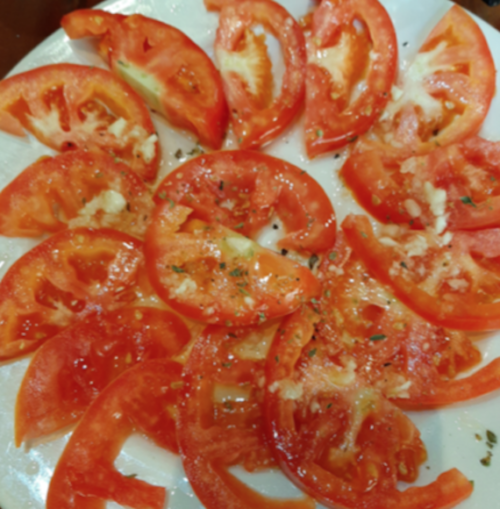
© Año Nuevo 2018, Going Postal
In Northern Spain tapas tends to be bread based, primarily because of the cooler climate. The favourites are pinchos (which means skewer) where a variety of tasty morsels are “skewered” to a bread base and montiditos which are basically small filled rolls. These have become popular nationwide through franchise chains like Lizzaran and 100 Montaditos and offer amazing value for money where a montaditos and a glass of Rioja can be had for as little as £3-50.

© Año Nuevo 2022, Going Postal
The other thing to note about bread-based tapas is the work that independent bar owners put in to have the best displays, the best wine and the best service to attract the most customers. This is gourmet sandwich on a scale that not even Waitrose can get close to and is a trillion miles away from the plastic-wrapped rubbish made by teams of hidden Africans for the lucrative British sandwich market. This is ultra yummy yum-yum scrummy food featuring everything from king-size prawns to octopus, black serrano ham to home-produced salchicon, goats cheese to aged manchego, ripe yellow peppers to large capers, fresh flaky cod to smoked sea bream, grilled artichokes to portobello mushrooms. This is not M&S Food, this is something far better and is available almost everywhere. (Even in Benidorm)
Recipe: Ensalada de anchicoria y queso azul
(Chicory and blue cheese salad)
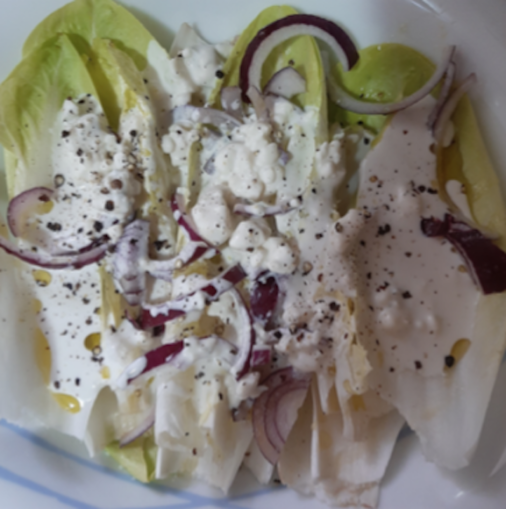
© Año Nuevo 2021, Going Postal
Ingredients:
1 x head of chicory.
2oz Soft blue cheese (like Gorgonzola)
1 x Tablespoon of mayonnaise.
4 x Tablespoon of milk
1/4 Red onion.
Extra virgin olive oil/salt and pepper to taste.
Method:
Peel the chicory leaves from the main stalk & arrange on a plate.
Drizzle with extra virgin olive oil and place in the fridge.
In a bowl mix the blue cheese and mayonnaise into a big mush & thin with a little milk mixing it until you have the consistency of double cream. Do not worry about cheesy lumps.
Pour the mixture over the chicory leaves and garnish with sliced red onion.
Salt and pepper to taste.
The beauty of the dish is combining the bitterness of chicory with the mellowness of cheese and the sweetness of onion.
Occasionally tapas has a ritual which is, to say the least, strange. In a small bar in Valencia, I once ordered Berberechos which caused a great deal of consternation. A waiter, with less English than I had Spanish, was sent to my table to find out if I knew what I was ordering. On learning that I knew that Berberechos were cockles he disappeared to return with a tin of North Atlantic cockles which he presented with the flamboyance of a man presenting a bottle of Beaune to the Queen.
When he returned, the juices that the cockles had lain in had been lovingly decanted into a “shot glass” and the little beasts were in a small earthenware bowl on a plate surrounded by dried slices of French bread. Unsure of the etiquette and now being watched by customers and staff alike I took a slice of bread, poured on a little liquid from the shot glass and topped it with a little mound of cockles before devouring it. In a single mouthful I had guessed right and gained rather a lot of kudos from the audience who were rather impressed that a foreigner not only knew what Berberechos were but also knew how to eat them.
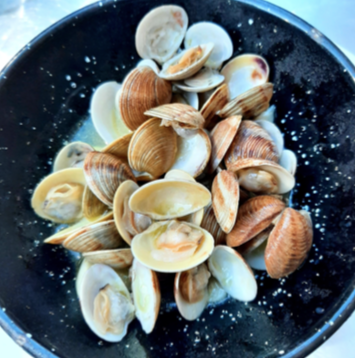
© Año Nuevo 2022, Going Postal
Lovers of shellfish are well catered for in Spain with over 20 varieties of prawn and shrimp, where the “redder” the article the more expensive it becomes. My own particular favourite though are razor clams, flash steamed and served with plenty of lemon juice, finely diced shallots and chopped parsley. Just ask for Navajas. They are lish!
At the age of seven I determined that Father Christmas did not exist, religion was a load of humbug and that the tastiest meats had a high-fat content, making belly pork a cornucopia of carnivorous delight, with the added benefit of crispy crackling and yummy dripping.
The Spanish are also in love with belly pork (pancetta) but in general do not roast it, preferring instead to use it in stews or to cure it with pimenton. The one exception to the rule can be found in Cadiz.
Recipe for chicharrones de Cadiz
(Prepared belly pork)
I generally buy a single piece of belly pork at about 14” x 8” and get the butcher to cut it in half vertically and horizontally giving four joints at 7” x 4”. Two joints I freeze to make roast belly pork with later and two joints I use to make chicharrones. It is very important though that you stop the butcher from scoring the skin with a Stanley knife, as many British butchers like to do. After washing and dabbing dry the two joints we are now ready to make the delicious chicharrones.
Ingredients:
Two pieces of belly pork.
One tablespoons of paprika.
One tablespoons of ground cumin.
Four pieces of crushed garlic.
One teaspoon of ground sea salt
Four fluid ounces of olive oil.
At this stage please do not get tempted to use any form of pepper, which seals the fibres of the meat and stops the process working.
Method:
In a bowl place the paprika, ground cumin, crushed garlic and ground salt.
Pour in the oil and mix thoroughly.
With the joint’s skin side down use a brush to apply the mixture to the meat or in the words of Ainsley give it a good rub letting the mixture saturate into the meat.
Place the two prepared joints skin side down into a roasting pan which has been drizzled with a minimum amount of olive oil.
The idea is to dry roast the meat and not have it saturated with fat.
Set the oven to 100 degrees Celsius and no higher. The cooking process is slow to allow the rub to penetrate the meat but to keep the meat fat firm. Place the roasting pan in the middle of the oven. Do not cover it with foil as this will cause condensation to drip through and dilute the rub. Cook for five hours. The skin will remain opaque while the meat cooks. Test with a skewer to ensure that no blood runs and remove from the oven. Allow to cool and then wrap the joints in foil and place in the fridge overnight.
The next day take a joint from the foil and carefully remove the skin. Cut the joint in half again and slice as thinly as possible. You will have a slight crust of garlic, while the meat will have flecks of orange caused by the paprika. Chicharrones is served cold as a tapas with bread dipped in oil and grilled to a golden brown. It is absolutely delicious.
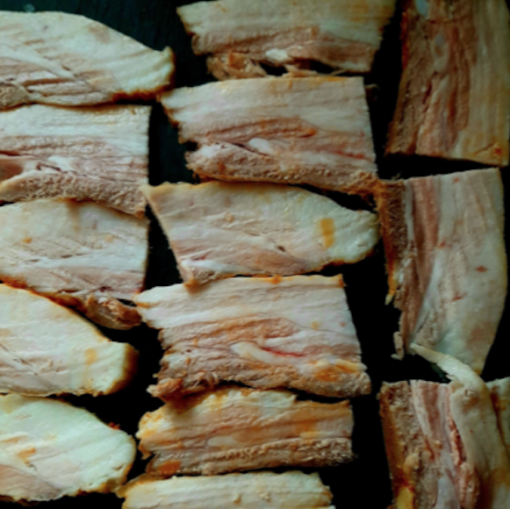
© Año Nuevo 2022, Going Postal
More than anything Tapas is really about getting together with friends and family to talk, eat and drink. Tapas restaurants rarely have WiFi and there is a real buzz about popular venues. There is also a tendency to sell wine from the local area, fine sherries if you are close to Jerez and in recent years Vermouth or Vermut has gained in popularity through a younger clientele who are knowledgeable about the best producers. Having tasted quite a few with ice and a slice of orange I can tell you they are a mile away from that sickly sweet beverage beloved by maiden aunts at Christmas in the 1970s. It has, if you like, grown better with age, but then haven’t we all.
To conclude, if you ever find yourself in Sevilla I can thoroughly recommend “Casa Paco” on the Alameda de Hercules. It has a fabulous tapas menu with daily specials, wonderful service from very knowledgeable staff, many of whom speak English, a great selection of wine and drinks and a buzz which almost hugs you.
As with most restaurants in Spain high customer volume only starts at 9 pm and Caso Paco has this fabulous ability to add a table and four chairs to their seating at will, such is its popularity that I fully expect them to reach Córdoba one day.
Pssssst try the ceviche of butterfish with a Vermut, it is fabulous.
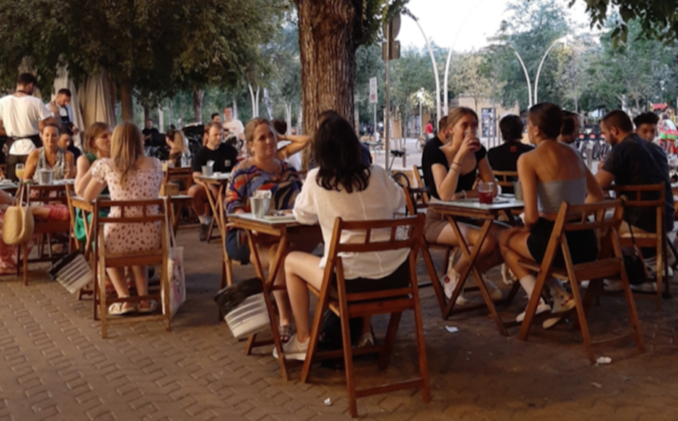
© Año Nuevo 2022, Going Postal
I fully expect that tapas restaurants and the sheer belligerence of the Spanish in preserving their food heritage will be more than enough to defeat the WEF in their bid to have us all exist on mealy worms.
© AÑO NUEVO 2022
Casa Paco
Bar la Cantina.
La Sacristia



